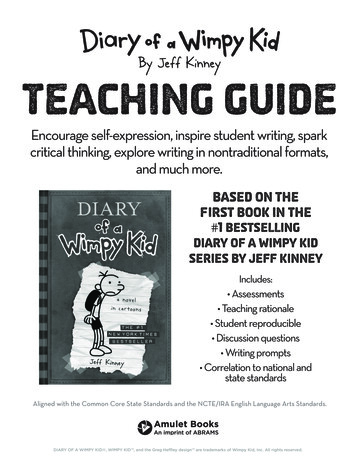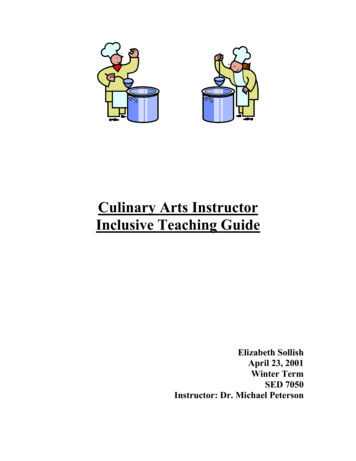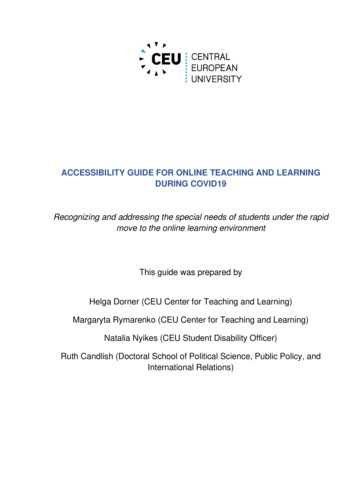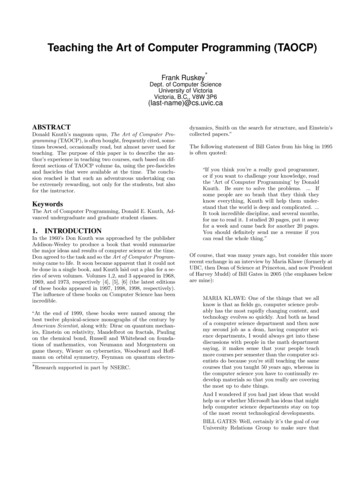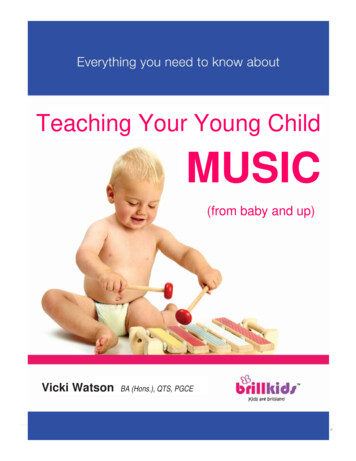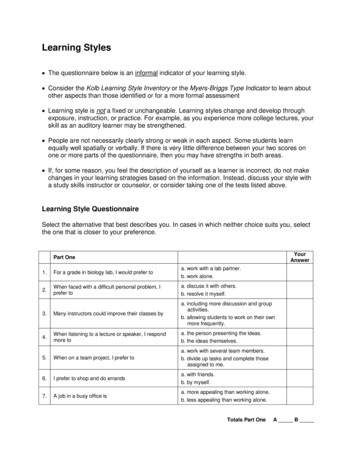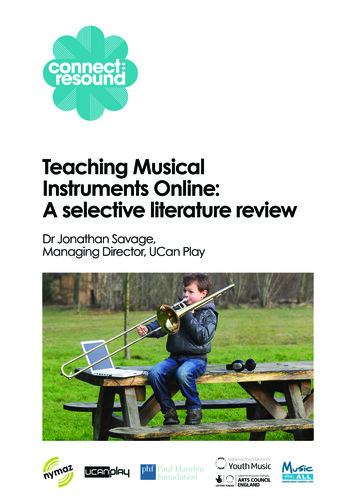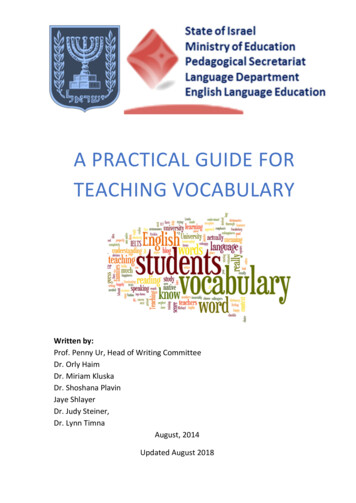
Transcription
A PRACTICAL GUIDE FORTEACHING VOCABULARYWritten by:Prof. Penny Ur, Head of Writing CommitteeDr. Orly HaimDr. Miriam KluskaDr. Shoshana PlavinJaye ShlayerDr. Judy Steiner,Dr. Lynn TimnaAugust, 2014Updated August 2018
A PRACTICAL GUIDE FORTEACHING VOCABULARYCONTENTSA. Information: Frequently asked questions and answers - The vocabularycomponent in the Curriculum, and the ways it will affect your teaching. . 3B. Implementing the vocabulary component in the classroom - (How canwe find the time?) General guidelines and strategies to improvevocabulary teaching and learning, with lots of practical ideas. 5C. More ideas 1: vocabulary expansion - Practical ideas for expandingstudents’ vocabulary at all levels. 10D. More ideas 2: presenting new vocabulary - Ways of presenting the formand meaning of new items. . 13E. More IDEAS 3: vocabulary review - Activities that get students to repeatand review vocabulary without getting bored. . 15F. More ideas 4: Advanced vocabulary activities . 25G. Vocabulary Assessment - Some useful ways of testing vocabulary. . 28H. Useful resources - Recommended Internet sites that provide vocabularywork (with notes telling you what they consist of), useful books, andinteresting research. 342
A PRACTICAL GUIDE FORTEACHING VOCABULARYA. INFORMATION: FREQUENTLY ASKED QUESTIONS ANDANSWERS - THE VOCABULARY COMPONENT IN THE CURRICULUM, AND THE WAYS ITWILL AFFECT YOUR TEACHING.WHY IS THERE A SECTION ON VOCABULARY TEACHING IN THE CURRICULUM?Four main reasons: Teachers and textbook writers have been saying for years that we needvocabulary and grammar lists to help achieve the benchmarks; Vocabulary is the most important component of language knowledge; it is one ofthe best predictors of language performance; Many students get to twelfth grade with a relatively small vocabulary, whichprevents them from achieving their potential (based on research done in Israel andabroad, Schmitt, 2008; Laufer). Students don’t just ‘pick up’ vocabulary from reading and listening. It needs tobe actively taught (see practical suggestions later in this booklet).WHAT DOES THE VOCABULARY SECTION OF THE CURRICULUM INCLUDE?Two main requirements: Core vocabulary lists of essential items for Foundation and Intermediate levels,of about 700 items each; a core vocabulary list of essential items for Proficiencylevel of about 1400 items 1. The number of vocabulary items students are expected to learn at each level,(items from the Core lists, plus other items chosen by textbook writers andteachers). These numbers are: about 1200 for Foundation, an additional 2000 atIntermediate, and another 2200 at Proficiency: about 5400 in all.This looks like a lot:but it includes many items which will have been taught in earlier years as part of the‘expansion’ vocabulary.13
A PRACTICAL GUIDE FORTEACHING VOCABULARYHOW DOES THIS AFFECT MY TEACHING OF VOCABULARY?You’ll need to spend quite a lot of lesson time on teaching new vocabulary andreviewing it throughout the year. This means probably about one-third of lessontime, on average, will be devoted to vocabulary work (there are lots of practicalideas in this booklet to help you do this).Also, you’ll need to take more care in selecting which items to teach: select the items you feel will be most useful to your students; include multi-word items (lexical chunks) like in any case.HOW MANY NEW VOCABULARY ITEMS SHOULD I TEACH IN A LESSON?In principle, about 12 new items a week in elementary school, about 20 in juniorhigh, about 30 in high school. This will vary of course, according to the individualclass: lower hakbatzot will learn fewer, classes of native speakers can be expectedto learn more. Remember you’ll need to set aside time also for review!HOW MUCH REVIEW DO I NEED TO DO?In order to make sure that students have mastered the items, they need to reviewthem at least ten times, probably more! Obviously, you can’t review every item tentimes, but you should make sure you do so several times. So this means that you’llneed to review new items you’ve taught not only at the end of the same lesson orunit, but will need to come back to them regularly over the whole year (see Myth 5below)4
A PRACTICAL GUIDE FORTEACHING VOCABULARYB. IMPLEMENTING THE VOCABULARY COMPONENT IN THECLASSROOM - (HOW CAN WE FIND THE TIME?) GENERAL GUIDELINESAND STRATEGIES TO IMPROVE VOCABULARY TEACHING AND LEARNING, WITH LOTS OFPRACTICAL IDEAS.REORGANIZATIONIt’s not a question of adding, it’s a question of reorganization.Two things you might cut down to make room for vocabulary work: Grammar.There is a tendency to devote too much time to grammar teaching, much ofwhich should be transferred to vocabulary. Checking homework.Often half the lesson is wasted on going through exercises students have donefor homework. Try just giving the answers, or writing them up on the board; students selfcheck and then respond only if there is a problem; giving them five minutes to check through the answers in pairs, askingyou only if there is a problem; taking in their homework to check at home (obviously you can’t do thisevery time, too time-consuming, but occasionally you can, and it savestime in class).5
A PRACTICAL GUIDE FORTEACHING VOCABULARYMYTHSThere are some assumptions that lead us to teach vocabulary not very efficiently,and which are not in fact true. Let’s look at some of these.MYTH #1: YOU SHOULDN’T TRANSLATE NEW WORDS INTO L1.Not true. You may. Use other means as well - pictures, mime, explanations,examples – but don’t feel guilty about clarifying by means of the L1. And of course,later review should be mainly in English: but for the first time you explain a word, L1can be really helpful.MYTH #2: IT’S MORE IMPORTANT TO TEACH READING STRATEGIES THAN VOCABULARY.Not true. Reading strategies are no substitute for knowing vocabulary. Learninghow to skim, scan, infer from context etc., is of surprisingly limited value in readingcomprehension when students don’t know enough vocabulary. So it’s not worthspending too much time practicing reading strategies: make students aware ofthem, certainly, but it’ll be much more helpful to them if you spend most of yourtime teaching and reviewing vocabulary.MYTH #3 VOCABULARY SHOULD ALWAYS BE TAUGHT AND REVIEWED IN (SENTENCEOR LONGER) CONTEXT.Not always. There’s a place for teaching and review of single items on their own.And often putting a new word into a brief phrase is just as helpful as putting it into afull sentence. Both these, of course, are much quicker than full-context activities.Bottom line: vocabulary should be taught both within contexts and as single,decontextualized, items.6
A PRACTICAL GUIDE FORTEACHING VOCABULARYMYTH #4: STUDENTS CAN ALWAYS GUESS MEANINGS FROM CONTEXT.Not true. They usually can’t. Not just because they’re untrained, and not justbecause the texts are too difficult, but simply because research shows that eveneducated native speakers often can’t guess a word from context correctly: thecontext doesn’t give enough clues to meaning. Only in the minority of cases doesthe surrounding context make the meaning of an unknown word clear. So don’twaste time pushing students to infer words in class: just tell them what they mean.(That doesn’t mean that inferring from context is useless – students will use it intheir own independent reading – only that it’s not a very efficient way to teach newwords in class).MYTH #5: IT’S ENOUGH TO EXPOSE A LEARNER THREE OR FOUR TIMES TO A NEWWORD FOR THEM TO LEARN IT.Not true. This isn’t enough. According to research, a learner will only master a newitem if he or she gets ten or more opportunities to review (some say as much as 20).So it’s important to review new items you taught at the end of the same lesson, andagain in the next lesson; but then remember that you’ll need to come back to themafter a week, and again later. Of course you won’t have time to review every singleitem ten or more times, but remind students to refresh their memories every nowand then (see Strategies below).MYTH #6: WHEN READING A NEW TEXT, STUDENTS CAN ALWAYS LOOK NEW WORDSUP IN A DICTIONARY, SO THEY DON’T NEED TO LEARN SO MANY IN ADVANCE.Not true. Looking up in a dictionary is time-consuming and often results in mistakes.And there’s research to show that students who use dictionaries for readingcomprehension understand no better than those who don’t! There is no substitutefor knowing lots of vocabulary. (Incidentally, the more vocabulary students know,the more likely they are to use dictionaries successfully when needed.)7
A PRACTICAL GUIDE FORTEACHING VOCABULARYSTRATEGIES AND PRACTICAL IDEASHere are some useful strategies for teaching vocabulary without adding extra workand time, together with practical ideas that use them.STRATEGY 1: MAKE STUDENTS RESPONSIBLE. Share with students why they need to learn a lot of vocabulary: it’s probably themost important aspect of language that they need to know.Tell students that they’ll need to work on vocabulary expansion themselvesoutside the lessons: there’s simply no time during lessons to teach them all thevocabulary they need and review it. There are some ideas in the next sectionabout ways students can expand their own vocabulary.Tell students to keep vocabulary / dictionary notebooks (could be onsmartphones or tablets) to keep a record of new vocabulary learnt.Give students five minutes during class to check through their vocabulary listsor notebooks and remind themselves of things they’ve learnt.Make opportunities for students to share their personal strategies for learningand reviewing new vocabulary.STRATEGY 2: USE QUICK, FIVE-MINUTE VOCABULARY ACTIVITIES EVERY LESSON. Ask students to call out all the items they’ve learnt in the last two weeks, writethem up as fast as you can. Add any they’ve forgotten.Challenge students in groups to recall as many items as they can: who canremember most?Have the items on the board at the beginning of the lesson; ask students to scanthem, say if there are any whose meaning they don’t remember; tell them.Dictate the items in L1, ask students to say the English equivalents (in chorus);or vice versa.Ask individual students to say one word or expression they’ve recently learnt orcome across. They/you explain meanings where necessary.Teach a new extra item (‘word of the day’) at the beginning of every lesson(could be an idiom or a proverb).Brainstorm all the words you know that have to do with (a topic).8
A PRACTICAL GUIDE FORTEACHING VOCABULARYSTRATEGY 3: USE HOMEWORK FOR VOCABULARY STUDY. If you can, send parents the lists of items you’ve taught so that they - or siblings,or grandparents - can help students at home (use the school website).Tell students to find a word or expression (in the textbook, literature,newspaper, Internet or any other source) that they didn’t know before, find outwhat it means, come to class and tell the others.Students spend 10 minutes (by the clock!) reviewing all the items they’ve beentaught over the last two weeks.Students look up six words they have already learnt in the dictionary and findout either a) added meanings or b) phrases that include them that they didn’tknow before.Students do vocabulary work online. See Section D. (More resources) for somerecommended websites.STRATEGY 4: COMBINE FLUENCY EXERCISES IN THE FOUR SKILLS WITH A FOCUS ONVOCABULARY. SPEAKINGGroups get a list of 20-30 items you want to review and tell (not write!) a storywhich brings in as many of the items as they can. Each student has to contributeat least one sentence. WRITINGGive each student a word or expression you want to review (remind them ofmeanings if necessary). Ask an informative question beginning ‘Can you tell meabout’ (e.g. ‘Can you tell me about someone in your family?). Students write asentence or paragraph that has to bring in their word or expression. Thenstudents share what they have written: read it aloud; or leave their own writingdisplayed on their tables and walk around reading other students’ texts. LISTENINGStudents write down the numbers 1-20 down the left-hand side of a page (orscreen). Say 20 statements (which can be true or false), each one including oneword or expression that you’ve recently taught and want to review. Studentswrite or x by each number, according to whether they think it is true or false.Then check answers.9
A PRACTICAL GUIDE FORTEACHING VOCABULARY READINGSame as for listening, but in writing.Simply ask them to reread a digital or photocopied text that included items youwant them to learn, underlining the items they remember you taught them. Theyask each other and/or you if there are any words in the text that they don’tremember.For more detailed explanations of some of these ideas, and lots more, see the nextsection.C. MORE IDEAS 1: VOCABULARY EXPANSION -PRACTICAL IDEAS FOREXPANDING STUDENTS’ VOCABULARY AT ALL LEVELS.You’ll see that ideas are coded, according to whether they are appropriate forelementary school (EL), junior high (JH), or high school (HS). Many of them areappropriate for two, or even all three, levels.BRAINSTORM: ASSOCIATIONS (EL, JH, HS)1. Give a theme word, students call out any other words or phrases that occur to themthat are associated, any part of speech.2. Add more yourself, and teach the new items.BRAINSTORM: WHAT GOES WITH ? (EL, JH, HS)1. Give a noun, students suggest all the adjectives that might describe it (e.g
TEACHING VOCABULARY . Written by: Prof. Penny Ur, Head of Writing Committee. Dr. Orly Haim. Dr. Miriam Kluska . Dr. Shoshana Plavin . Jaye Shlayer . Dr. Judy Steiner, Dr. Lynn Timna . August, 2014 . Updated August 2018 . A PRACTICAL GUIDE FOR TEACHING VOCABULARY . 2 . CONTENTS A. Information: Frequently asked questions and answers - The vocabulary component in the

